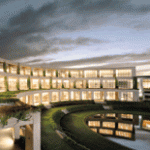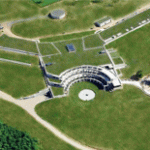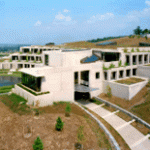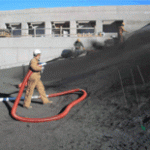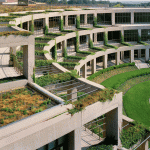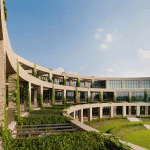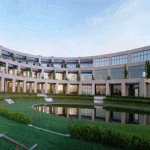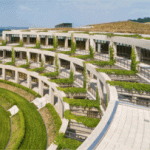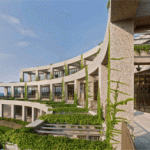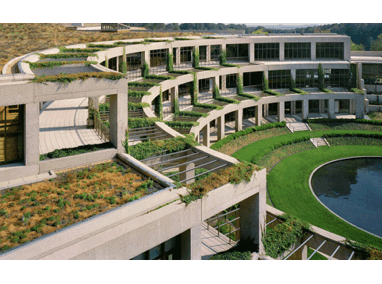
Additional Resources
The Library of Congress National Audio-Visual Conservation Center (NAVCC) Packard Campus is located at 19053 Mount Pony Road, Culpeper, VA 22701-7551; Phone: 202.707.5840. Learn more about the Library of Congress Packard Campus at their website, where you can also see a 13:54 minute video. Read the write up on Wikipedia here and the September 28, 2007 “Library of Congress Gives Hillside Bunker a New Use” by Russell Boniface in AIArchitect here. See the following case studies: Packard Campus Architecture, Architect of the Capitol; SmithGroup, DPR Construction, Emory Knoll Farms, and Stalite/PermaTill.
For more information about the National Audio-Visual Conservation Center, contact Jonathan Cantwell of SmithGroup at 202.974.4591. Read about the following companies in The Greenroof Directory: Stalite/PermaTill and Emory Knoll Farms. The NAVCC is featured in the 2012 Greenroofs & Walls of the World? Calendar in the month of April.
Built in a classical style, the $120 million Library of Congress Packard Campus of National Audio-Visual Conservation Center (NAVCC)facility – a former Cold War United States Federal Reserve bunker – is built into the side of Mount Pony in Culpeper, Virginia, southwest of Washington, D.C., with 80% of the structure below grade. The Packard Campus was created through a unique partnership between the Packard Humanities Institute, the United States Congress, the Library of Congress, and the Architect of the Capitol.
“Set on a beautiful 45 acre campus with stunning architectural design and landscaping, the Packard Campus of the National Audio-Visual Conservation Center is a state-of-the-art facility where the Library of Congress acquires, preserves and provides access to the world?s largest and most comprehensive collection of films, television programs, radio broadcasts, and sound recordings. The Campus has globally unprecedented capabilities and capacities for the preservation reformatting of all audiovisual media formats (including obsolete formats dating back 100 years) and their long-term safekeeping in a petabyte-level digital storage archive. In addition to preserving the collections of the Library, the Packard Campus was also designed to provide similar preservation services for other archives and libraries in both the public and private sector.
“The physical description of the Campus is impressive enough?415,000 square feet, more than 90 miles of shelving for collections storage, 35 climate controlled vaults for sound recording, safety film, and videotape, 124 individual vaults for more flammable nitrate film?but it will also be a “factory” for acquisitions, preservation, access, and partnerships. For example, the Campus will feature an off-air recording room to enable off-broadcast, off-cable, off-satellite capture of hundreds of channels of audiovisual content,” (Library of Congress, see below).
The Library of Congress project included a major two-phase renovation and addition to house the motion picture, broadcasting and recorded sound facility in four parts; construction began in August 2003 and was completed in the fall of 2006. The Library of Congress is the largest library in the world, and the NAVCC is also one of the largest greenroofs in the U.S. The vegetated roof protects the film vaults which contain the nation’s heritage of film in their original nitrate form.
“SmithGroup covered the Library of Congress’ National Audio Visual Conservation Center with a 228,000 square foot garden roof ranging in depth from 6″ to 48” of soil cover. While blending the design into the rural Virginia hillside, the green roof has the added benefit of helping to keep the temperatures inside the archival storage facility stable for up to two weeks in the event of a long-term power outage, a necessity to preserve the world’s largest collection of audio-visual artifacts. The roof and surrounding campus added over 9,000 trees and nearly 200,000 individual plantings making the project one of the largest private sector reforestation projects on the eastern seaboard (SmithGroup, see below).
International Leak Detection (ILD) performed the EFVM? integrity test on the various roof slopes to ensure the membrane installation was watertight prior to the installation of the plantings. The EFVM? Vextor-9 conductor wires are permanently installed to allow for monitoring the integrity of the membrane through the vegetation overburden.
The Library of Congress Packard Campus of National Audio-Visual Conservation Center has received the following awards: Mid-Atlantic Construction Magazine Best of 2007 Overall Project of the Year; 2007 AGC Washington Contractor Award; 2007 National Association of Industrial and Office Properties 21st Annual Best of NAIOP Awards; Best Building, Institutional Facility Over $20 Million – 2007; and the 2007 Green Innovation Award – Best Green Commercial Project from the Virginia Sustainable Building Network.
 Greenroofs.comConnecting the Planet + Living Architecture
Greenroofs.comConnecting the Planet + Living Architecture
